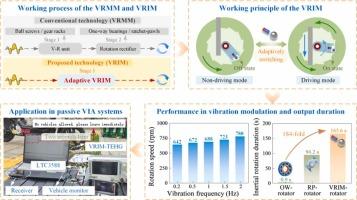Adaptive vibration-rotation integrated modulator for harvesting low-frequency energy toward self-powered vehicle intrusion alarming system
IF 17.1
1区 材料科学
Q1 CHEMISTRY, PHYSICAL
引用次数: 0
Abstract
The pedestrian walkway area is prone to incidents of motor vehicle intrusion, posing a threat to pedestrian safety. Roadbed vibration energy can contribute to self-powered vehicle intrusion alarming (VIA) systems for improving pedestrian safety, but its efficient exploitation is highly difficult due to the adverse low-frequency and intermittent features. This paper introduces an adaptive vibration-rotation integrated modulator (VRIM) that can transform low-frequency vibrations directly to unidirectional and high-speed rotation to increase output power and extend output duration. Enabled by a simple-structured friction-driving mechanism and an innovative magnetic rotation rectifier, the VRIM can output 642 rpm high-speed rotation as actuated by 0.2 Hz low-frequency vibration. Based on the VRIM, a triboelectric-electromagnetic hybrid nanogenerator (VRIM-TEHG) is designed for implementing both energy harvesting and self-driven sensing of different vibration sources. It is demonstrated that, under 1 Hz low-frequency vibration, the VRIM-TEHG can deliver an electrical power of 71 mW and achieve a high output frequency of 160 Hz. After the vibration vanishes, the high-frequency electric outputs can still sustain for 148 s, indicating that the VRIM-TEHG can provide continuous electric outputs even if the vibration frequency is well below 0.01 Hz. A passive VIA system is further constructed with the VRIM-TEHG and its feasibility is verified through outdoor tests, which highlights the promising application of the VRIM-TEHG in harnessing ambient low-frequency vibration energy and achieving self-sufficient smart systems for transportation.

自供电车辆入侵报警系统低频能量采集的自适应振动-旋转集成调制器
行人通道区域容易发生机动车辆闯入事故,对行人安全构成威胁。路基振动能量可以为自供电车辆入侵报警系统(VIA)提供能量,以提高行人的安全,但由于其低频和间歇性的不利特性,其有效利用难度很大。本文介绍了一种自适应振动-旋转集成调制器(VRIM),它可以将低频振动直接转换为单向高速旋转,从而提高输出功率和延长输出持续时间。通过结构简单的摩擦驱动机构和创新的磁旋转整流器,VRIM可以在0.2 Hz的低频振动驱动下输出642 rpm的高速旋转。在此基础上,设计了一种摩擦电-电磁混合纳米发电机(VRIM- tehg),实现了能量收集和不同振动源的自驱动传感。实验证明,在1 Hz的低频振动下,vtrim - tehg可以提供71 mW的电力,并实现160 Hz的高输出频率。振动消失后,高频电输出仍能持续148 s,说明即使振动频率远低于0.01 Hz, vtrim - tehg也能提供连续的电输出。利用VRIM-TEHG进一步搭建了被动式VIA系统,并通过室外试验验证了其可行性,凸显了VRIM-TEHG在利用环境低频振动能量、实现交通智能系统自给自足方面的广阔应用前景。
本文章由计算机程序翻译,如有差异,请以英文原文为准。
求助全文
约1分钟内获得全文
求助全文
来源期刊

Nano Energy
CHEMISTRY, PHYSICAL-NANOSCIENCE & NANOTECHNOLOGY
CiteScore
30.30
自引率
7.40%
发文量
1207
审稿时长
23 days
期刊介绍:
Nano Energy is a multidisciplinary, rapid-publication forum of original peer-reviewed contributions on the science and engineering of nanomaterials and nanodevices used in all forms of energy harvesting, conversion, storage, utilization and policy. Through its mixture of articles, reviews, communications, research news, and information on key developments, Nano Energy provides a comprehensive coverage of this exciting and dynamic field which joins nanoscience and nanotechnology with energy science. The journal is relevant to all those who are interested in nanomaterials solutions to the energy problem.
Nano Energy publishes original experimental and theoretical research on all aspects of energy-related research which utilizes nanomaterials and nanotechnology. Manuscripts of four types are considered: review articles which inform readers of the latest research and advances in energy science; rapid communications which feature exciting research breakthroughs in the field; full-length articles which report comprehensive research developments; and news and opinions which comment on topical issues or express views on the developments in related fields.
 求助内容:
求助内容: 应助结果提醒方式:
应助结果提醒方式:


